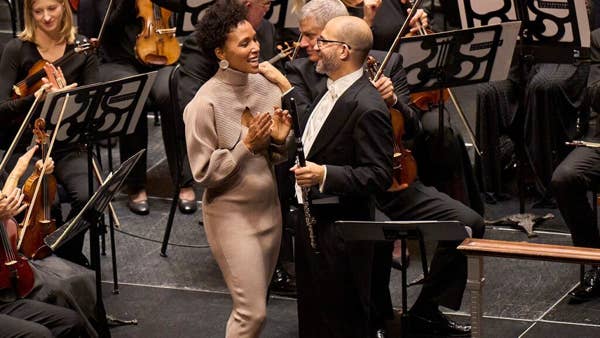The Grit, Grace & Glory of Allison Loggins-Hull
The Daniel R. Lewis Composer Fellow reflects on three years with The Cleveland Orchestra and the premiere of her brand-new piece in May.

Allison Loggins-Hull wasn’t there for the afternoon that would change her life. It was October 3, 2021 — unseasonably humid, remembers Cleveland Orchestra Principal Flutist Joshua Smith. He and other Orchestra members were putting on a “Porchestra” concert on the stoop of the Cozad-Bates House, a pre–Civil War home believed to have acted as a safe house along the Under-ground Railroad.
He’d decided to play Homeland, a solo piece Loggins-Hull wrote in 2018. Smith had been besotted with the work since a friend introduced him to it some months before. “She knows how to exploit an in-betweenness with [instruments], like the delicate bends that you can get between notes,” Smith says of Loggins-Hull’s writing.

Cleveland Orchestra Music Director Franz Welser-Möst attended that concert. He, too, was impressed — so much so that he requested more scores from Loggins-Hull. A few months after sending some samples, Loggins-Hull learned she had been selected as the Orchestra’s next Daniel R. Lewis Composer Fellow. She’d had no idea she was even being considered. “They asked me if I wanted to do it, and I was like, ‘Come again?’” she says, laughing in disbelief at the memory. “I didn’t believe it; I didn’t see it coming.”
Loggins-Hull has written across solo, chamber, and orchestral configurations. Much of her work strikingly incorporates electronics — samples, delay, looping. Others, like Homeland and Can You See? — her 2023 commission for the Orchestra — mimic electronic effects but are purely acoustic.
Loggins-Hull viewed her time in Cleveland as an invitation to play in a purely orchestral sandbox. And what better sandbox exists than The Cleveland Orchestra? “I’ve never heard an orchestra sound that great. That’s the truth,” she says. “I’ve sat in on rehearsals; I’ve listened to so many concerts and recordings. The opportunity to work with this orchestra has informed my concept of orchestration and color in a priceless way.”
Arguably, Loggins-Hull’s tenure has been just as transformative for the Orchestra as it has for her. Previous Daniel R. Lewis Composer Fellows held the fellowship for two years. Loggins Hull asked that hers be extended to three so she could forge deeper connections with the city.
Those connections later inspired Legacy, a string sextet commissioned by the Orchestra last season. The piece references concerts held onsite with three community partners: the Fatima Family Center in Hough; Karamu House, the city’s historical Black theater; and the Hryhory Kytasty Cleveland School of Bandura, a Ukrainian music school. Performers from all three organizations convened at Severance Music Center last May to play at a concert featuring Legacy’s premiere.
Welser-Möst, reflecting on Loggins-Hull’s tenure, praised her as “an extraordinary person and a wonderful composer.” He continued, “The way she has reached out to the Cleveland community during her fellowship — she’s become a star. People have fallen in love with her in such a great way.”
Still ahead is Loggins-Hull’s third and final commission for the Orchestra, premiering May 8–10. Titled Grit. Grace. Glory., she says the 20-minute piece is her most ambitious work to date and is “informed by everything,” from the people she met in Cleveland to her own personal reflections following her father’s death last April.
“I really wanted it to be a piece for The Cleveland Orchestra — this specific orchestra and this specific place, [with] its own energy and rhythm,” Loggins Hull says. “I was able to include other people’s voices, stories, and histories but still do it in my voice, without over-shadowing their narratives.”
The driving first movement, Steel, nods to literal and metaphorical railways through Cleveland. In a full-circle moment, she was thinking about the Cozad-Bates House as she wrote it, pivotal not just to survivors of slavery but to Loggins-Hull’s own path to The Cleveland Orchestra. It’s followed by the slower, more meditative Shoreline Shadows. That movement incorporates improvisations by Cleveland School of the Arts students in response to Loggins-Hull’s prompt: “What does Cleveland mean to you?”
She titled the exuberant third movement Quip, a celebration of the city’s self-deprecating humor. Throughout, instrument sections have to slot in intricately placed offbeats. “It’s a musical ‘humblebrag,’” she explains. “The material itself is not complicated, but it’s written in such a way that the Orchestra can show off.”
The finale movement, Ode, opens with chorales referencing material from earlier in the piece. But it ends in a very different place altogether, on a hard-rocking tutti in the spirit of Led Zeppelin’s “Kashmir.” “I mean, how can I ignore rock n’ roll? That would be a huge oversight,” Loggins-Hull says with a giggle. “I even told them in the score: ‘Rock out.’”
Spoken like a true rock star herself.
— Hannah Edgar is a Chicago-based culture writer. Their work appears regularly in the Chicago Tribune, Chicago Reader, Musical America, DownBeat, and the Cincinnati Symphony Orchestra’s Fanfare magazine.